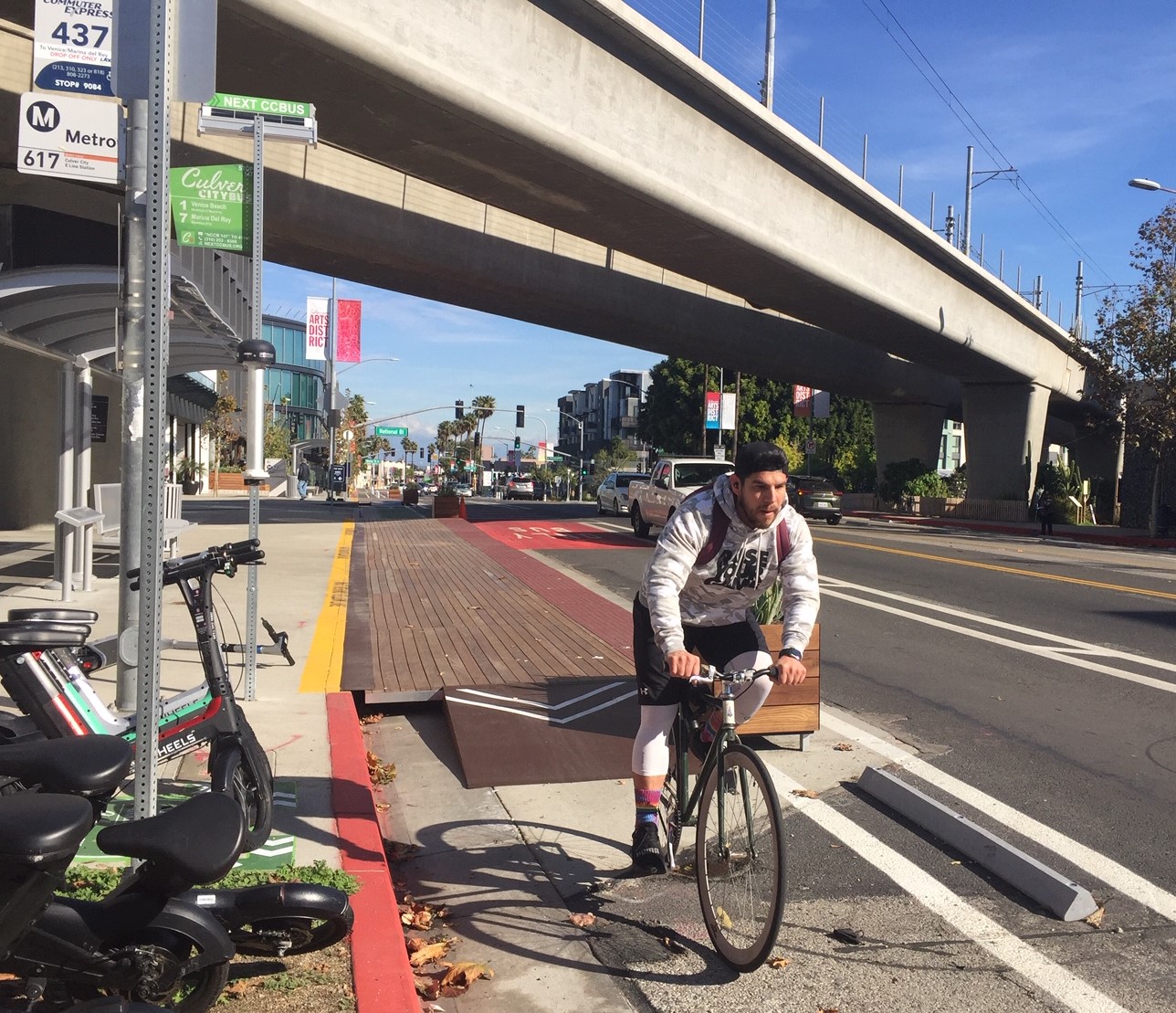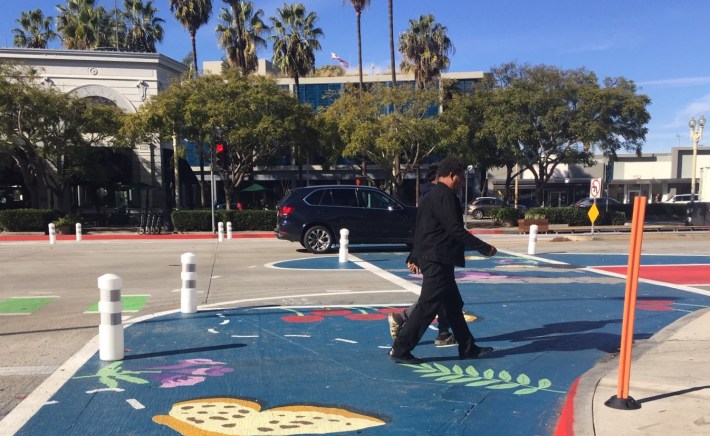Last month, Culver City celebrated the opening of extensive changes on Washington and Culver Boulevards to prioritize safety and green transportation. The MOVE Culver City project features improvements for pedestrians, transit riders, and cyclists. The improvements connect Culver City's Metro E (Expo) Line Station to its downtown, city hall, and arts district. Buses get 1.3 miles of dedicated bus lanes. Some of that is shared bus/bike lane, with about three-quarters of a mile of separated protected bike lanes running alongside dedicated bus lanes.
According to the project website, MOVE Culver City "envisions a reimagining of our streets as public spaces and prioritizes moving people over cars in the design of the street. Bus riders, cyclists, and emergency vehicles will all benefit from increased speeds, ease of travel, and reliability of connections to key destinations."
The new permanent project builds on similar popular temporary street reconfigurations done during COVID. Even though the MOVE Culver City improvements are dramatic and far-reaching, they are considered "quick-build." The improvements feature relatively low-cost materials: mainly paint, plastic bollards, signage, planters, removable platforms, and the like. There is minimal costly concrete curb construction - though the project does include bicycle signalization at some intersections, which can be expensive.
The overall project cost approximately $2.65 million, which breaks down to $906 thousand for design and approximately $1.74 million for construction. Project funding sources include local funds for transit and active transportation projects, Measure M funds, a Metro MAT (Metro Active Transport, Transit and First/Last Mile program) grant, and federal transit funds.
The ribbon-cutting for #MOVECulverCity is completed! Join us Downtown to:
— City of Culver City (@CulverCityGov) November 21, 2021
🚴 Utilize the newly completed bike lanes
🚎 Ride the circulator, which arrives every ten minutes
🎨 Enjoy the asphalt artwork painted by members of the #CulverCity community
(1/2) pic.twitter.com/GDqIjOUyTG
According to a city press release regarding the November 20 opening, outgoing Mayor Alex Fisch proclaimed that "With MOVE Culver City, we're meeting increasing transportation demands proactively by implementing new, safe, fast options for you to get around your community.” Culver City Chief Transportation Officer Rolando Cruz added that the city is “creating the infrastructure to support public transit, pedestrians, and cyclists, which will reduce both emissions and traffic." Culver City's new Mayor, Dr. Daniel Lee added, “Building out and connecting bus, bicycle, pedestrian and micro-mobility infrastructure is a priority for the Culver City City Council. MOVE Culver City is only the beginning of that work, which is crucial for ending the needless injuries and deaths caused by traffic violence on our streets.”
The facility is open, though as of this week there was still a small amount of construction still underway along Washington, just west of the E Line.
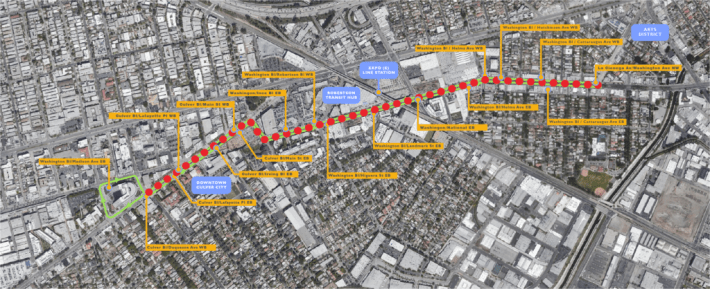
For pedestrians, the city has set aside numerous curb extensions, also called bulb-outs. These, and crosswalks, have been painted blue, with artwork titled “Scenes from Ballona Creek.” The dispersed street mural features "wildlife from the Ballona Wetlands and relevant species found in Culver City."


As started under COVID, the city has smartly left the one short restaurant-lined block of Main Street (between Culver and Venice Boulevards) closed to car traffic. The block is packed with outdoor dining, and serves as a convenient cut-through for pedestrians and cyclists - and emergency vehicles.
The project area bus stops now feature boarding platforms - similar to ones in downtown L.A. (on MyFigueroa below 7th Street, and temporarily on First Street at L.A. City Hall.) These platforms are raised, with cyclists using short ramps to get on and off. The MOVE Culver City project includes about a dozen of these boarding platforms.

In addition to serving Culver City Bus Line 1, which travels to Venice Beach, the bus-only lanes also support a new Route 1C1 Culver City Downtown Circulator which runs the length of MOVE Culver City (Culver/Duquesne to Washington/La Cienega Avenue.) The electric, low-floor minibus runs every ten minutes at peak times and every fifteen minutes at off-peak times - and is currently offering free rides through June 30, 2022.
For cyclists, the configurations vary - and can be slightly confusing when first riding there. The bike lanes shift between protected and shared bus/bike lanes in several places. Some of the more complicated intersections now have dedicated bike signals, though in most places cyclists follow the existing traffic signals.
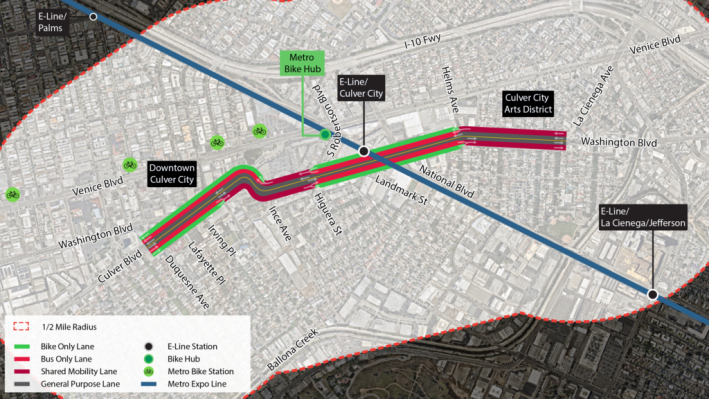
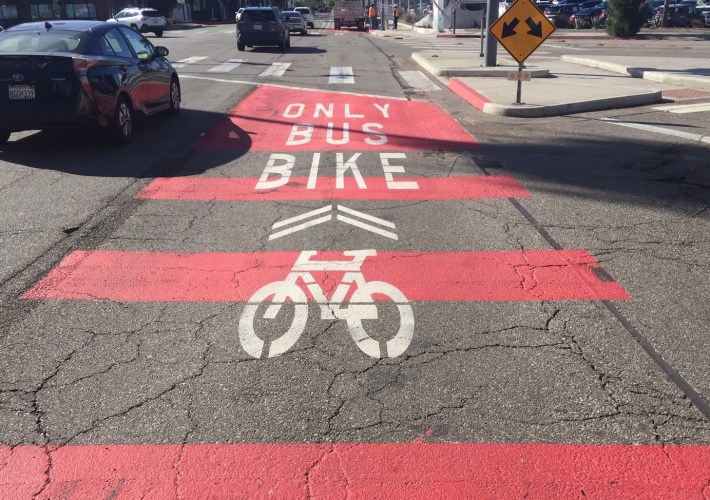
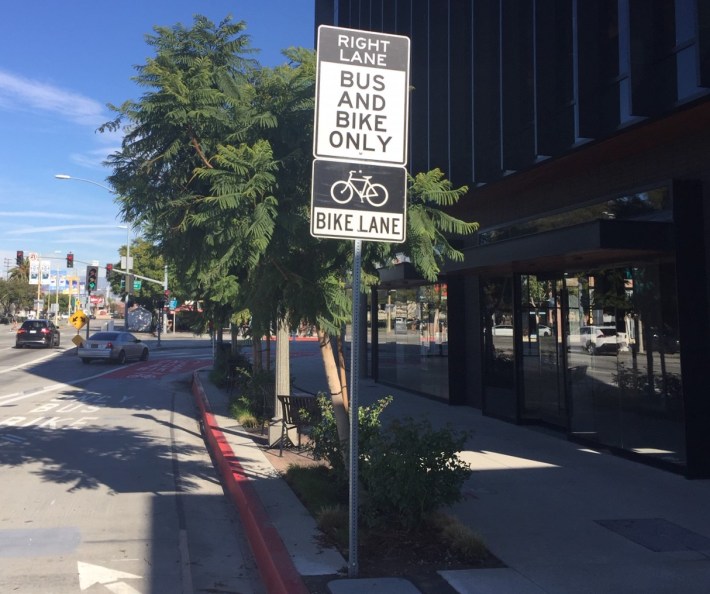
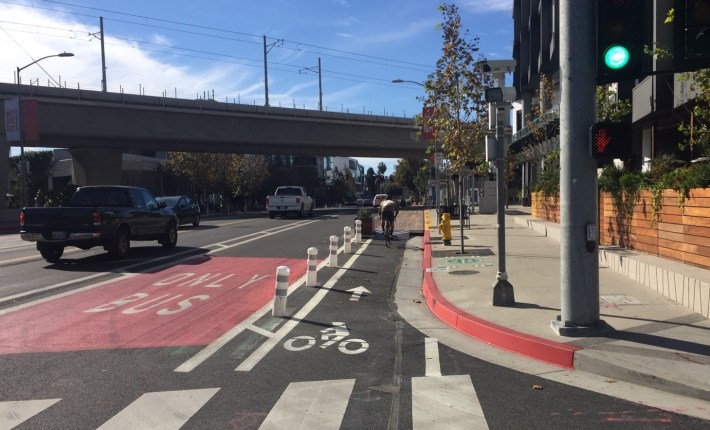

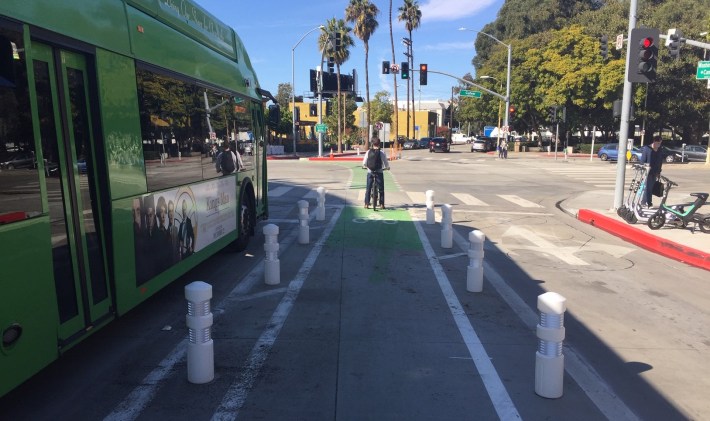
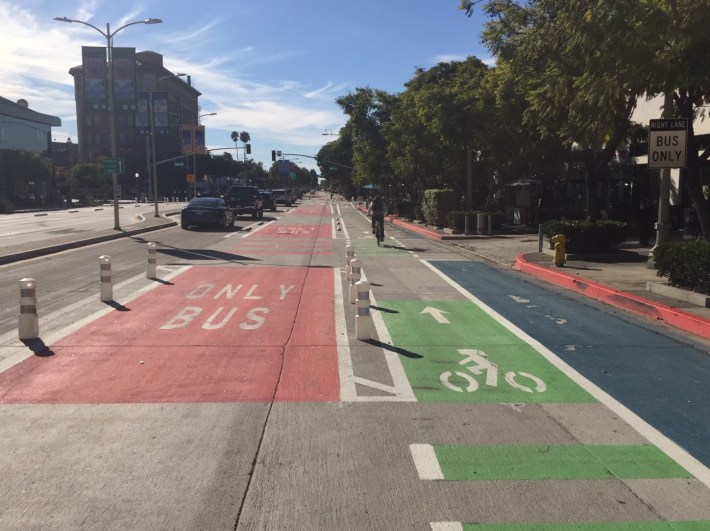
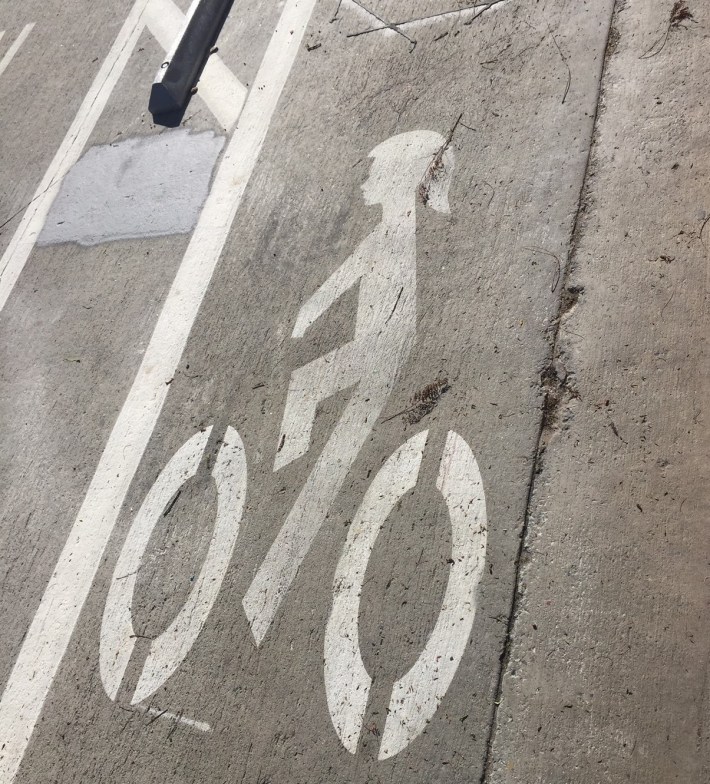
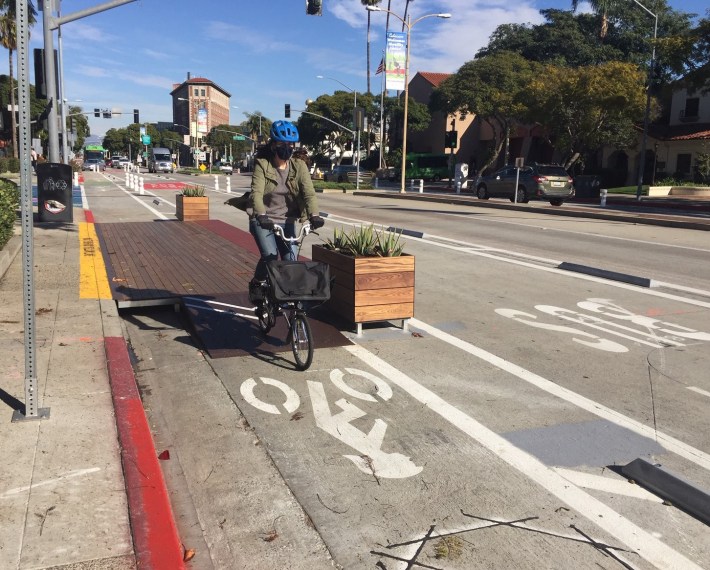
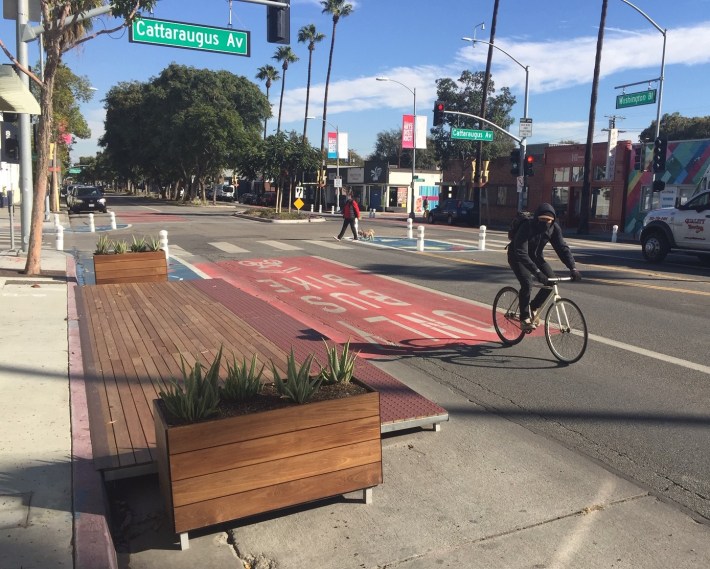
Overall the facility does a very good job of making existing walking and bicycling patterns much safer. Like Culver City's recent Elenda Street protected bike lanes, the design does not just end midblock, but smartly facilitates expected cyclist behavior. One example of this is the Washington/Robertson bike box, which supports cyclists turning left to get to E Line station bike hub.
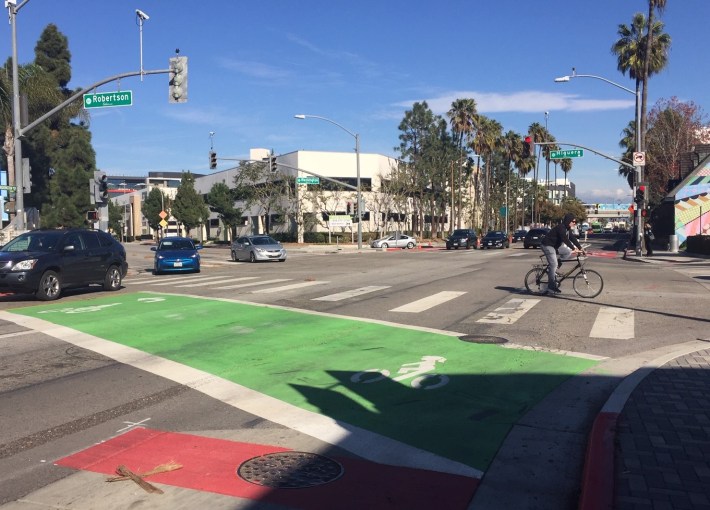
The project has received praise, mainly from cyclists and transit advocates, via social media.
I kept hearing about all the gridlock in downtown CC. So I went to check it out on a rainy Tuesday at 4:17p. And… looks pretty good! #moveculvercity pic.twitter.com/OlrSiSEYcr
— Vice Mayor McMorrin (@YasmineMcMorrin) December 15, 2021
After over a year of planning, the quick-build bus/bike #MoveCulverCity mobility project in @CulverCityGov has taken less than a month to construct. Love the artistic elements. I biked thru the 🚧 today. Looks good! Launch is Nov 20 w/ @AlexFischCC 🚌🚴 @StreetsblogLA pic.twitter.com/25OuqAMPzL
— Eli Lipmen (@elipmen) November 18, 2021
The project also has detractors on social media. Some folks who drive have been critical of making permanent the lane reconfigurations piloted under COVID. Drivers still have a dedicated lane, but space formerly set aside for cars is now balanced between multiple modes.
For climate, safety, and health, this spatial reallocation should be the future of America's ubiquitous transit-served, five lane arterial. @CulverCityGov #MoveCulverCity project. pic.twitter.com/ER5h8MEUNo
— Mike Lydon (@MikeLydon) December 1, 2021
The Washington and Culver Boulevard sections are phase 1 of MOVE Culver City, with additional quick-build project phases planned for Sepulveda Boulevard and Jefferson Boulevard.
For further explanation of various features of MOVE Culver City, visit the city's project website.
This post was updated 12/17 2:30 p.m. to include project cost figures and an additional quote.
